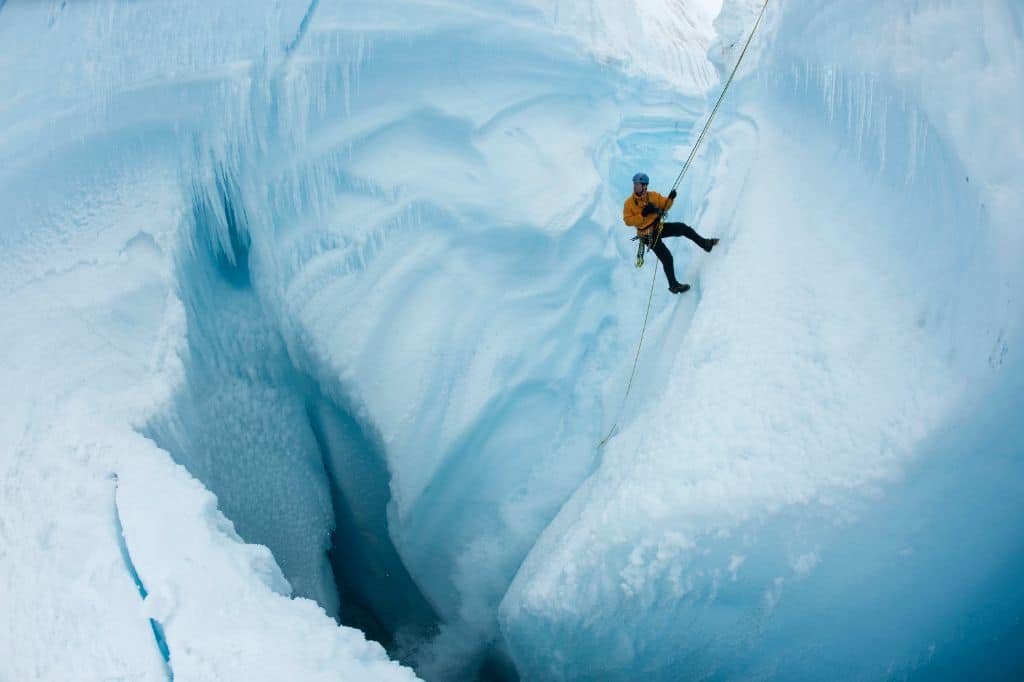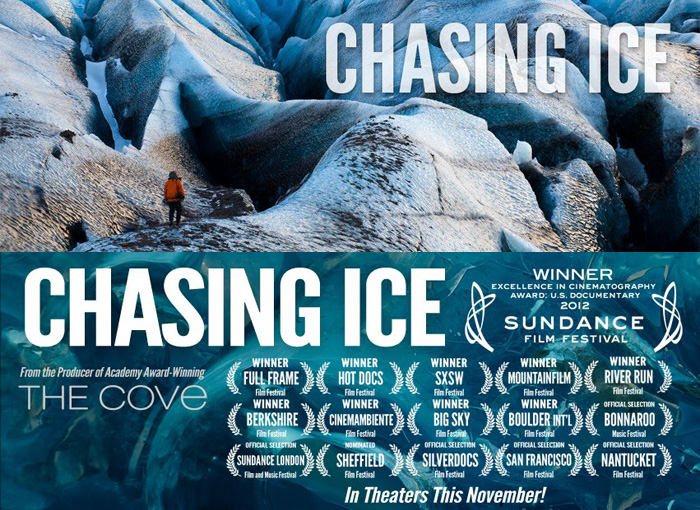I wanted to challenge my normal film club attendees. I often screen wildlife films and TV series that leave you feeling good or with messages about climate change tacked in at the end. But this time I wanted to go for a campaign film. One with a clear mission. And one where the film captures a project that would have happened with or without the film crew. I.e. making the film was not the mission but to communicate a message about the project being filmed.
And (not so secretly) I wanted to go in see how we felt about the role of the adventurer – the classic explorer and hero. A story or mono-myth that is often discussed to be problematic, but informs many of our traditional and favourite myths and modern tales.1
So, for my second Reel Nature environmental film club of the academic year, I screened Chasing Ice (2012), directed by Jeff Orlowski. The film is about famed photographer, James Balog, who traveled and photographed remote areas of the Arctic with his team in his mission to capture undeniable evidence of how the changing climate is changing our planet. This film documents Balog’s dangerous journey and his efforts with his team to photograph the melting glaciers, which is all part of his Extreme Ice Survey project. Aesthetically breath taking and emotional, this film had a big impact across media and society and my film club audience too.
“Inspired.”

When asking audiences how they felt after watching, it was rather unanimous that the audiences’ main response was that they found the film inspirational. Many commented of the sadness they felt when they watched Balog’s journey and when they were faced with his bleak and picturesque photographs of the melting glaciers. They spoke of the power of these images to shock and engage audiences, beyond that of facts and figures, and how they effectively capture emotions that enabled an audience to engage and empathise with the issue at their heart.
Despite the widespread emotional impact, not everyone was able to resonate and connect with the main characters – a small group of white, Western, upper/middle class males which isn’t relatable for many audiences. Furthermore, the topic of the melting Arctic is so far from all of our lived experience, so it was hard to feel a personal connection with that unknown natural landscape. The group acknowledged that the film may impact global audiences differently due to its lack of relatability and the amount of science and scientists included. However, the emotional journey and the strength of the final message seemed to translate well within our film club with each member personally feeling impacted by the film.
Role of the explorer

It was Balog’s personal sacrifice and the risks he took that many of the film club’s audience quoted as their main source of inspiration. They saw this sacrifice as a demonstration of deep care for the planet. And it was this, alongside his photographs, that helped to communicate the true urgency of the mission.
Balog’s commitment seemed to communicate and make accessible emotions of fear and grief that where reflected by the risks he took within the landscape to get his desired footage. It is his physical and personal ‘heroes journey’ that created an arch that the audience members felt they could relate and empathise with. In this form, the film provided a space or container for the audience to feel like they were part of something larger than just them. A community of like-minded people who held similar values and cared for our planet. A space where they wouldn’t be judged or have to justify and explain themselves. They knew that the film club was a bit of an echo-chamber and the self-selecting audience members would belong to the same bubble. But they questioned if he was able to use the film to target wider audiences, they too might feel the same connection.
Despite my questioning of the heroes tale, the role these stories play as vessels for audiences emotions, for making them feel less alone in these complex interconnected global crises, is something I learnt from the screening. And something I will consider more in my future film clubs and research.
What will you do next?

As a campaign film, it is created with a key purpose, one to create impact in some way. Impact is notoriously hard to measure as it can happen in a diverse range of areas, such as the communities and landscape you film in, the audience that watch it, and the policy surrounding the main topic. This is just a few possible options. But without some way of measuring these changes, it is hard to prove any impact actually took place2.
There is evidence in the film itself of the impact Balog’s project impacted different audiences. And there is evidence across media that people really enjoyed the film, it has won a lot of awards and been screened at many festivals. But the only way I really have to see what impact it has on audiences is through the discussions in my film clubs. So I asked them: what will you do next?
There was a very mixed variety of responses! From going further into environmental science education to learn more about the issues in the film. To making a film or their own media campaign to spread the word. Some commented about wanting to go and see these locations and travel the world, which they admitted was a strangely ironic reaction – the wanting to “see these places before they disappear”. It ignited a love to travel and explore the world, it is “now or never” as when we are older many of these places will no longer exist.
One of the responses, which I must admit resonated with me, was wanting to talk about the climate and ecological crises more in every day life. It was brave what Balog and his team did. And through their bravery they found a way to tell an important story. It feels like a brave thing to create an open conversation with people outside of our bubble, in a place we know we will be judged and where we might judge others, about what we care about. As if we create a space for open conversation with other bubbles, they might find an emotional connection too. One that can help to bridge a gap between different groups communities that haven’t yet heard a story they feel they can relate to.
- Here is a helpful overview, but worth a bit of research if you are interested: https://bigthink.com/high-culture/monomyth-heros-journey-campbell/ ↩︎
- To read more about Impact Production in film, television and media I recommend you look at this brilliant resource from the Doc Society: https://impactguide.org/ ↩︎
Main picture credit: https://ryanmariotti.com/chasing-ice/
